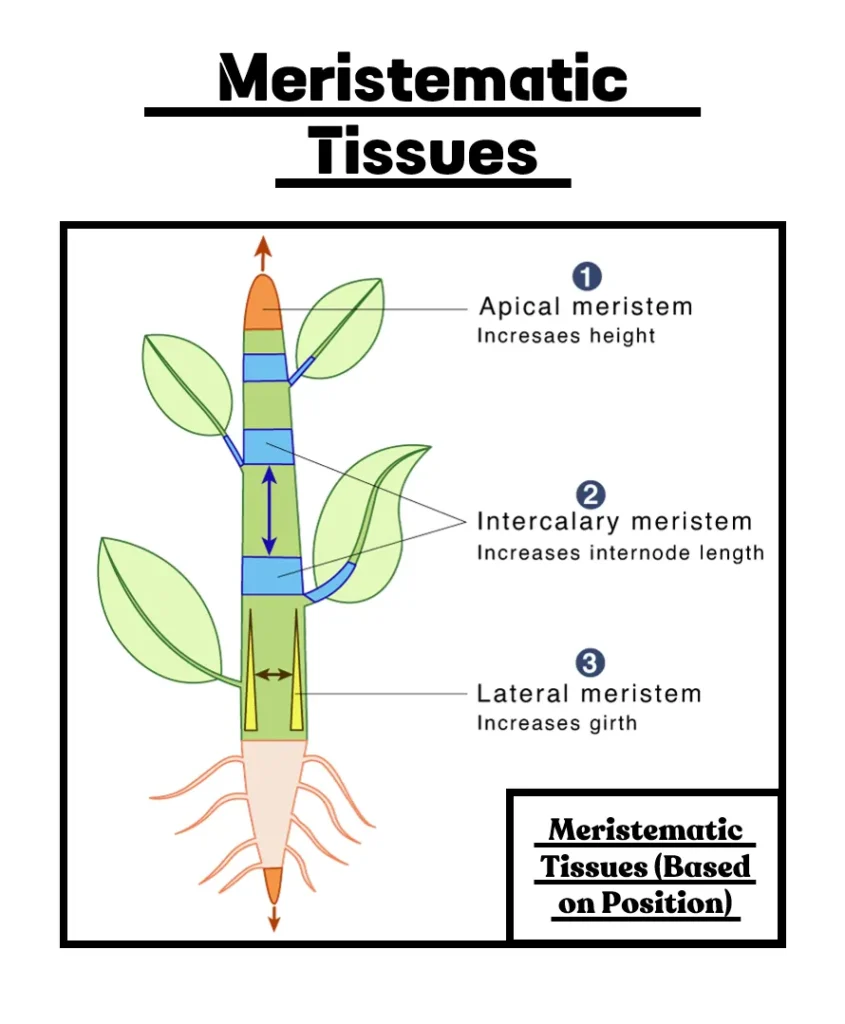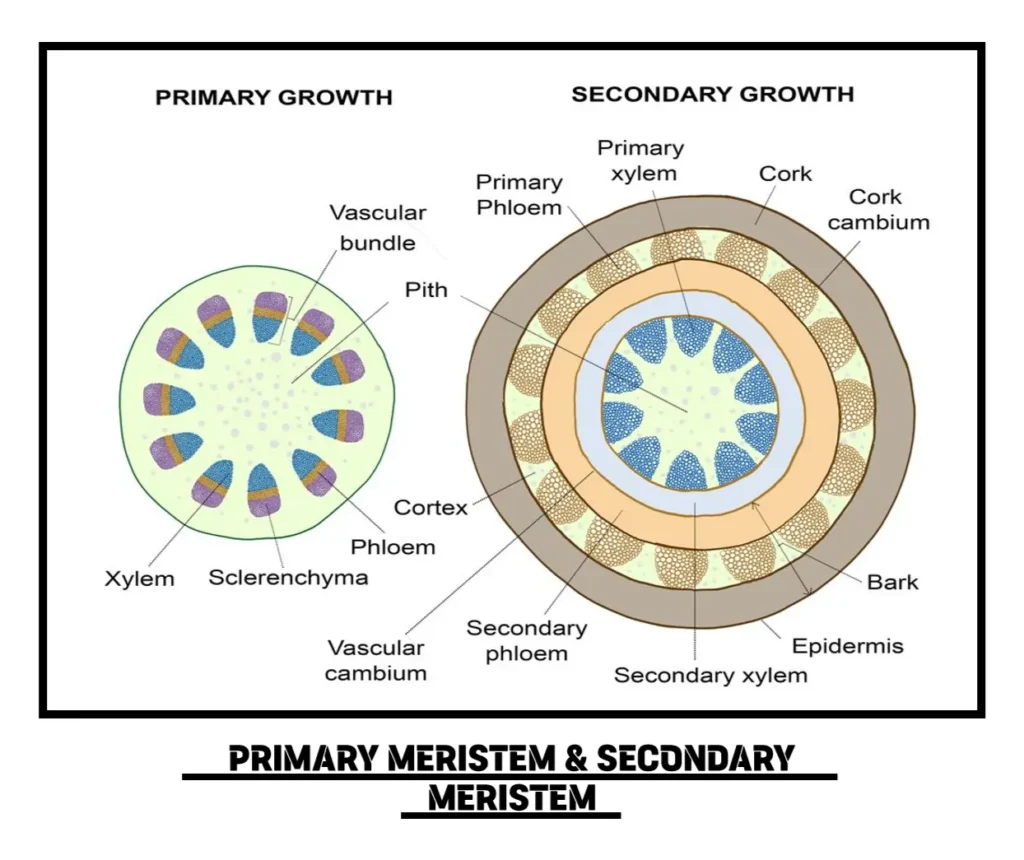Plants, unlike animals, exhibit remarkable plasticity in their growth, continuously forming new organs and tissues throughout their lives. This ability is driven by meristematic tissues, specialized regions of actively dividing cells that serve as the foundation for plant development. These tissues are classified based on their position, origin, function, and plane of division, each category shedding light on their unique contributions to plant structure and adaptability.
This article explores the intricate world of meristematic tissues, delving into their classifications, roles, and significance in the life of plants, with examples that highlight their impact in both natural and agricultural contexts.
Table of Contents
Classification Based on Position
The location of meristematic tissues within a plant dictates their role in growth and development. Position-based classification divides meristems into three primary types: apical meristems, intercalary meristems, and lateral meristems, each contributing to distinct aspects of plant morphology.

Apical Meristem: The Vanguard of Primary Growth
Located at the tips of roots and shoots, apical meristems are the driving force behind primary growth, which elongates the plant’s axes, allowing it to reach for sunlight or anchor deeper into the soil. The shoot apical meristem (SAM), found at the farthest point of the stem, orchestrates the formation of leaves, stems, and floral organs. For instance, in a sunflower, the SAM meticulously coordinates the development of its iconic flower head, ensuring the precise arrangement of florets in a spiral pattern. Similarly, the root apical meristem (RAM) promotes root elongation, enabling plants to access water and nutrients from deeper soil layers.
Apical meristems are organized into distinct zones that reflect their specialized functions:
- Promeristem zone: Composed of apical initials, a small group of actively dividing cells that maintain the meristem’s activity.
- Meristematic zone: Includes three key regions:
- Protoderm, which differentiates into the epidermis, the plant’s protective outer layer.
- Procambium, which forms the vascular tissues (xylem and phloem) for nutrient and water transport.
- Ground meristem, which gives rise to the cortex and pith, provides structural support and storage.
This zonal organization ensures that apical meristems contribute to both the structural and functional needs of the growing plant. In fast-growing plants like maize, the SAM’s efficiency allows the plant to rapidly produce leaves and reproductive structures, supporting its agricultural importance.
Intercalary Meristem: The Engine of Regenerative Growth
Intercalary meristems are unique in their placement between mature, differentiated tissues, typically found in monocots like grasses, bamboos, and certain regenerating plant parts. These meristems are critical for internode elongation, enabling plants to extend their stems or leaves without relying solely on apical growth. For example, in grasses, intercalary meristems at the base of leaf blades facilitate rapid regrowth after grazing or mowing, a trait that makes lawns and pastures resilient to frequent cutting.
The regenerative capacity of intercalary meristems is particularly evident in plants like bamboo, where these meristems drive the rapid elongation of internodes, allowing the plant to achieve impressive heights in a short period. In pine trees, intercalary meristems at the base of needles contribute to needle elongation, enhancing the plant’s photosynthetic capacity. This adaptability underscores the evolutionary advantage of intercalary meristems in environments where plants face frequent mechanical stress or herbivory.
Lateral Meristem: The Architects of Secondary Growth
Lateral meristems, located along the lateral sides of stems and roots, are responsible for secondary growth, which increases the plant’s girth and structural stability. The two primary types of lateral meristems are the vascular cambium and the cork cambium (phellogen), each contributing to distinct tissues.
The vascular cambium produces secondary xylem (wood) and secondary phloem, the vascular tissues that enhance water and nutrient transport while adding to the plant’s structural integrity. In woody plants like oaks, the vascular cambium forms annual growth rings, each ring representing a year of secondary growth. These rings not only strengthen the tree but also serve as a historical record of environmental conditions, such as drought or abundant rainfall.
The cork cambium, on the other hand, generates the periderm, a protective layer that replaces the epidermis in woody plants. The periderm, including the cork (phellem), cork cambium, and phelloderm, shields the plant from mechanical damage, pathogens, and water loss. In trees like pines, the thick bark formed by the cork cambium provides insulation against fire and extreme temperatures, contributing to their longevity.
Classification Based on Origin
The developmental origin of meristematic tissues provides insight into their formation and evolutionary significance. This classification divides meristems into primordial (promeristem), primary, and secondary meristems, each reflecting a different stage of plant development.

Primordial Meristem: The Embryonic Foundation
The primordial meristem, or promeristem, is the earliest form of meristematic tissue, originating in the embryo during seed development. Comprising a small group of initial cells, the promeristem serves as the foundation for all plant organs. During germination, these cells divide repeatedly to form the primary meristems that give rise to the root and shoot systems.
For example, in a germinating bean seedling, the promeristem initiates the development of the embryonic root (radicle) and shoot (plumule), setting the stage for the plant’s early growth. The promeristem’s role is critical, as any disruption during this stage can impair the plant’s ability to establish itself. Its small size and high division rate make it a focal point for studying plant developmental biology.
Primary Meristem: The Builders of the Primary Plant Body
Primary meristems are direct derivatives of the promeristem, retaining their meristematic activity at the apices of roots, stems, and leaf primordia. These meristems, including apical and intercalary meristems, are responsible for constructing the primary plant body, which includes the leaves, stems, and roots of young plants.
In herbaceous plants like lettuce, primary meristems drive the rapid production of leaves, enabling the plant to maximize photosynthesis during its short growing season. In monocots like rice, primary meristems ensure the formation of a robust root system, critical for nutrient uptake in waterlogged soils. The versatility of primary meristems allows plants to adapt to diverse environmental conditions, from arid deserts to flooded paddies.
Secondary Meristem: The Guardians of Long-Term Growth
Secondary meristems arise from permanent tissues that regain meristematic activity later in the plant’s life, typically in woody species. These meristems, including the vascular cambium and cork cambium, produce secondary tissues like wood and bark, which are essential for long-term growth, protection, and structural support.
The vascular cambium, for instance, is formed from dedifferentiated parenchyma cells in the cortex or pith, which resume division to produce secondary xylem and phloem. In trees like maples, this process results in the accumulation of dense wood, valued for timber and furniture. The cork cambium, derived from cortical or epidermal cells, forms the periderm, which protects woody plants from environmental stresses like drought, pests, and fire. In cork oak trees, the thick periderm is harvested as commercial cork, demonstrating the economic significance of secondary meristems.
Classification Based on Function
The functional roles of meristematic tissues highlight their contributions to specific plant tissues, categorized into protoderm, procambium, and ground meristem. Each type is specialized to form distinct tissues that collectively ensure the plant’s survival and growth.
Protoderm: The Protective Shield
The protoderm is the outermost meristematic layer, giving rise to the epidermis, the plant’s first line of defense against environmental challenges. The epidermis protects against mechanical damage, water loss, and pathogen invasion, while also facilitating gas exchange through stomata.
In desert plants like cacti, the protoderm produces a thick, waxy epidermis that minimizes water loss, enabling survival in arid conditions. In aquatic plants like water lilies, the protoderm forms a thin, flexible epidermis that supports efficient gas exchange in waterlogged environments. The protoderm’s adaptability underscores its critical role in plant ecology.
Procambium: The Vascular Lifeline
The procambium forms the xylem and phloem, the vascular tissues responsible for transporting water, nutrients, and sugars throughout the plant. These tissues are essential for maintaining the plant’s metabolic balance and supporting rapid growth.
In fast-growing plants like bamboo, the procambium ensures the development of an extensive vascular network, enabling the plant to transport nutrients efficiently during its rapid elongation phase. In agricultural crops like wheat, the procambium’s efficiency directly impacts grain yield, as robust vascular tissues support the transport of sugars to developing seeds.
Ground Meristem: The Structural Core
The ground meristem produces the cortex, pericycle, and pith, which provide structural support, storage, and sometimes additional meristematic activity. These tissues are critical for the plant’s mechanical stability and nutrient storage.
In root vegetables like carrots, the ground meristem contributes to the fleshy cortex, which stores carbohydrates and other nutrients, making the root a valuable food source. In woody plants like pines, the ground meristem forms the pith, which provides structural support in young stems before secondary growth takes over. The ground meristem’s versatility makes it a key player in both herbaceous and woody plants.
Classification Based on Plane of Division
The plane in which meristematic cells divide determines the shape and arrangement of the resulting tissues, classified into mass meristem, rib meristem, and plate meristem. This classification highlights the structural diversity of meristematic activity.
Mass Meristem: The Bulk Builders
The mass meristem divides in all planes, producing a bulk of cells that form tissues like the endosperm in seeds or callus tissue in wound healing. This type of meristem is critical for creating storage tissues that support embryonic or regenerative growth.
In cereal grains like corn, the mass meristem forms the endosperm, a nutrient-rich tissue that nourishes the developing embryo during germination. In tissue culture, mass meristems are exploited to regenerate entire plants from small explants, demonstrating their biotechnological potential.
Rib Meristem: The Linear Organizers
The rib meristem divides in a single plane, producing rows of cells that contribute to tissues like the cortex or pith in roots and stems. This organized division pattern ensures the structural integrity of these tissues.
In the roots of plants like onions, the rib meristem forms the cortex in neat rows, enhancing the root’s ability to store water and nutrients. This orderly arrangement also facilitates efficient nutrient transport, supporting the plant’s overall growth.
Plate Meristem: The Flat Formers
The plate meristem divides in two planes, forming flat, plate-like structures such as the epidermis or epiblema. This division pattern is essential for creating the protective outer layers of leaves, stems, and roots.
In broad-leaved plants like maples, the plate meristem produces a smooth, expansive epidermis that maximizes photosynthetic surface area while protecting against environmental stress. In roots, the plate meristem forms the epiblema, a specialized epidermal layer that facilitates water and nutrient uptake.
Significance of Meristematic Tissues in Plant Growth and Agriculture
The classification of meristematic tissues provides a comprehensive framework for understanding their roles in plant growth and development. From the apical meristems that drive primary elongation to the lateral meristems that ensure secondary thickening, each type of meristem contributes to the plant’s ability to adapt to its environment. The origin-based classification highlights the developmental transitions that enable plants to progress from embryonic to mature stages, while the functional classification underscores the specialized tissues that support survival. The plane of division classification reveals the structural diversity that underlies plant morphology.
In agriculture, meristematic tissues are critical for crop improvement and propagation. For example, intercalary meristems in grasses ensure rapid regrowth after harvesting, supporting sustainable pasture management. Secondary meristems in woody crops like fruit trees contribute to long-term productivity by enhancing structural stability and nutrient transport. In biotechnology, mass meristems are used in tissue culture to propagate disease-free plants, revolutionizing the production of crops like bananas and orchids.
Conclusion
Meristematic tissues are the unsung heroes of plant growth, orchestrating the development of roots, shoots, leaves, and protective layers that enable plants to thrive in diverse environments. By classifying these tissues based on their position, origin, function, and plane of division, we gain a deeper appreciation for their complexity and versatility. From the towering sequoias driven by lateral meristems to the resilient grasses powered by intercalary meristems, these tissues embody the dynamic nature of plant life. As we continue to explore and harness their potential, meristematic tissues will remain at the heart of efforts to enhance agricultural productivity and sustainability, ensuring a greener future for generations to come.
Acknowledgements
The development of the article Classification of Meristematic Tissues: The Architects of Plant Growth was made possible through the wealth of knowledge provided by numerous reputable online resources. These platforms offered valuable insights into the biology, classification, and significance of meristematic tissues, ensuring the accuracy and depth of the content. We express our sincere gratitude to the following websites for their contributions to the scientific foundation of this article:
- Nature
- ScienceDirect
- Britannica
- Khan Academy
- Biology Online
- Plant Physiology
- Royal Society Publishing
- Encyclopedia of Life
- Oxford Academic
- Frontiers in Plant Science
- American Society of Plant Biologists
- Botanical Society of America
Related Articles
- Meristematic Tissues in Plant Growth: A Detailed Exploration
- Characteristics of Meristematic Tissues: The Powerhouse of Plant Growth
- Classification of Meristematic Tissues: The Architects of Plant Growth
- Permanent Tissues in Plants: A Comprehensive Guide
- Simple Permanent Tissues: The Foundation of Plant Anatomy
- Complex Permanent Tissues: The Vascular Lifelines of Plants
Frequently Asked Questions (FAQs)
FAQ 1: What Are Meristematic Tissues and Why Are They Important in Plants?
Meristematic tissues are specialized regions in plants composed of actively dividing cells that drive growth and development. These tissues are essential because they enable plants to continuously produce new organs, such as leaves, roots, and stems, throughout their lives, a trait known as indeterminate growth. Unlike animals, plants rely on meristems to adapt to environmental changes, repair damage, and sustain long-term growth, making them the cornerstone of plant morphology.
The importance of meristematic tissues lies in their versatility and regenerative capacity. For example, in agriculture, meristems are harnessed in tissue culture to propagate disease-free crops like bananas, ensuring high yields. In natural ecosystems, meristems allow plants to recover from herbivory or mechanical stress, as seen in grasses that regrow after grazing. Their classification based on position, origin, function, and plane of division provides a framework for understanding their diverse roles, from elongating roots to forming protective bark.
- Primary growth: Meristems like the apical meristem drive elongation, enabling plants to reach sunlight or deeper water sources.
- Secondary growth: Lateral meristems, such as the vascular cambium, increase plant girth, supporting structural stability in trees.
- Regeneration: Intercalary meristems in grasses facilitate rapid regrowth, critical for pasture sustainability.
FAQ 2: How Are Meristematic Tissues Classified Based on Their Position?
Meristematic tissues are classified by their position in the plant, which determines their specific contributions to growth. The three main types are apical meristems, intercalary meristems, and lateral meristems, each located in distinct regions and serving unique functions.
Apical meristems, found at the tips of roots and shoots, are responsible for primary growth, elongating the plant’s axes. The shoot apical meristem, for instance, produces leaves and flowers, as seen in sunflowers where it orchestrates the spiral arrangement of florets. Intercalary meristems, located between mature tissues, drive internode elongation in monocots like bamboo, enabling rapid height increases. Lateral meristems, such as the vascular cambium and cork cambium, facilitate secondary growth, increasing girth in woody plants like oaks, where annual rings of wood are formed.
- Apical meristem zones: Include the promeristem (apical initials) and meristematic zone (protoderm, procambium, ground meristem).
- Intercalary meristem example: Grass regrowth after mowing relies on these meristems at leaf bases.
- Lateral meristem impact: The cork cambium forms protective bark in trees, shielding against environmental stress.
This positional classification highlights how meristems work together to ensure comprehensive plant development, from elongation to thickening.
FAQ 3: What Is the Role of Apical Meristems in Plant Growth?
Apical meristems, located at the tips of roots and shoots, are the primary drivers of primary growth, which increases a plant’s height and length. The shoot apical meristem (SAM) produces stems, leaves, and reproductive organs, while the root apical meristem (RAM) extends roots to access water and nutrients. These meristems are critical for establishing the plant’s basic architecture during early development.
The SAM and RAM are organized into specialized zones. The promeristem zone contains actively dividing apical initials, maintaining the meristem’s activity. The meristematic zone includes the protoderm (forming the epidermis), procambium (forming vascular tissues), and ground meristem (forming cortex and pith). For example, in maize, the SAM efficiently produces leaves and tassels, supporting its rapid growth as a crop. Similarly, the RAM in carrots drives root elongation, enabling nutrient storage in the cortex.
- Functional diversity: Apical meristems produce multiple tissue types, ensuring structural and metabolic needs are met.
- Agricultural significance: In crops like rice, apical meristems drive early growth, impacting yield potential.
- Environmental adaptation: Root elongation by the RAM helps plants access deeper water in arid regions.
FAQ 4: How Do Intercalary Meristems Contribute to Plant Regeneration?
Intercalary meristems, found between mature tissues in monocots like grasses and bamboo, play a vital role in internode elongation and regeneration. Unlike apical meristems, which are located at tips, intercalary meristems are embedded within differentiated tissues, making them uniquely suited for regrowth after damage or harvesting.
These meristems enable plants to extend stems or leaves rapidly, a trait critical for species facing frequent mechanical stress. For instance, in lawns, intercalary meristems at the base of grass blades drive regrowth after mowing, ensuring a lush appearance. In bamboo, these meristems facilitate the rapid elongation of internodes, allowing the plant to achieve towering heights. Their regenerative capacity also supports plants like pine trees, where intercalary meristems at needle bases contribute to needle elongation.
- Regenerative advantage: Intercalary meristems allow grasses to recover from grazing, supporting pasture ecosystems.
- Structural role: They enhance stem flexibility in monocots, preventing breakage in windy conditions.
- Biotechnological potential: These meristems are studied for their role in crop resilience and propagation.
FAQ 5: What Is the Significance of Lateral Meristems in Woody Plants?
Lateral meristems, including the vascular cambium and cork cambium, are responsible for secondary growth, which increases the girth of stems and roots in woody plants. This process enhances structural stability and longevity, allowing trees to withstand environmental challenges and support large canopies.
The vascular cambium produces secondary xylem (wood) and secondary phloem, which improve water and nutrient transport while adding to the plant’s strength. In oaks, the vascular cambium forms annual growth rings, each ring reflecting a year’s growth and environmental conditions. The cork cambium generates the periderm, a protective layer that replaces the epidermis, shielding the plant from pathogens, fire, and water loss. For example, the thick bark of pines, formed by the cork cambium, insulates against forest fires.
- Structural support: Secondary xylem provides the wood that supports tall trees like sequoias.
- Protective function: The periderm in cork oaks is harvested as commercial cork, showcasing economic value.
- Environmental record: Growth rings serve as historical data for climate studies, aiding ecological research.
FAQ 6: How Are Meristematic Tissues Classified Based on Their Origin?
Meristematic tissues are classified by their origin, reflecting their developmental stages and roles in plant growth. The three categories are primordial meristem (promeristem), primary meristem, and secondary meristem, each marking a distinct phase of tissue formation.
The primordial meristem, or promeristem, originates in the embryo and forms the foundation for all plant organs. During germination, it initiates root and shoot development, as seen in bean seedlings. Primary meristems, derived from the promeristem, include apical and intercalary meristems, driving the primary plant body’s growth in young plants like lettuce. Secondary meristems, such as the vascular and cork cambium, arise from differentiated tissues that regain meristematic activity, producing secondary tissues like wood and bark in trees like maples.
- Embryonic role: The Promeristem establishes the plant’s basic structure during early development.
- Primary growth: Primary meristems ensure rapid leaf and stem formation in herbaceous plants.
- Secondary growth: Secondary meristems enhance longevity in woody species, critical for timber production.
FAQ 7: What Are the Functional Roles of Meristematic Tissues?
Meristematic tissues are classified by function into protoderm, procambium, and ground meristem, each producing specific tissues that support plant survival and growth. These functional roles ensure the plant’s structural integrity, protection, and metabolic efficiency.
The protoderm forms the epidermis, a protective outer layer that guards against water loss and pathogens. In cacti, the protoderm produces a waxy epidermis to conserve water in deserts. The procambium gives rise to xylem and phloem, the vascular tissues that transport water and nutrients. In bamboo, the procambium supports rapid growth by ensuring efficient nutrient delivery. The ground meristem produces the cortex, pericycle, and pith, which provide storage and support. In carrots, the ground meristem forms the nutrient-rich cortex, a key food source.
- Protective role: The epidermis from protoderm enhances plant resilience in harsh environments.
- Vascular efficiency: Procambium ensures robust transport systems, critical for crop yields.
- Storage capacity: Ground meristem contributes to nutrient storage, vital for root crops.
FAQ 8: How Does the Plane of Division Affect Meristematic Tissues?
The plane of division in meristematic tissues determines the shape and arrangement of resulting tissues, classified into mass meristem, rib meristem, and plate meristem. This classification highlights the structural diversity of meristematic activity.
The mass meristem divides in all planes, forming a bulk of cells, such as the endosperm in seeds. In corn, this meristem creates nutrient-rich endosperm for embryonic growth. The rib meristem divides in a single plane, producing rows of cells, like the cortex in onion roots, enhancing structural integrity. The plate meristem divides in two planes, forming flat structures like the epidermis in maple leaves, which maximizes photosynthetic surface area while providing protection.
- Storage function: Mass meristem supports seed development, critical for crop propagation.
- Structural organization: Rib meristem ensures orderly tissue arrangement in roots.
- Protective layers: Plate meristem forms expansive epidermal surfaces, aiding photosynthesis.
FAQ 9: Why Are Meristematic Tissues Critical for Agriculture?
Meristematic tissues are vital for agriculture because they drive plant growth, regeneration, and adaptation, directly impacting crop productivity and sustainability. Their roles in primary growth, secondary growth, and regeneration support the development of robust crops and resilient farming systems.
For example, apical meristems in crops like rice ensure rapid leaf and stem growth, maximizing photosynthetic capacity and yield. Intercalary meristems in grasses enable regrowth after harvesting, supporting sustainable pasture management. Lateral meristems in fruit trees enhance structural stability, ensuring long-term productivity. In biotechnology, mass meristems are used in tissue culture to propagate disease-free plants, revolutionizing crops like orchids.
- Yield enhancement: Apical meristems drive early growth, critical for grain crops.
- Sustainability: Intercalary meristems support regrowth in grazed pastures, reducing land degradation.
- Biotechnology: Meristems enable clonal propagation, ensuring uniform, high-quality crops.
FAQ 10: How Do Meristematic Tissues Contribute to Plant Adaptation?
Meristematic tissues enable plants to adapt to diverse environmental conditions by facilitating growth, regeneration, and structural modifications. Their classification by position, origin, function, and plane of division underscores their versatility in responding to ecological challenges.
In arid environments, the protoderm from apical meristems produces a thick, waxy epidermis in cacti, reducing water loss. In flood-prone areas, procambium in rice forms efficient vascular tissues, supporting nutrient transport in waterlogged soils. Intercalary meristems in grasses allow rapid regrowth after herbivory, ensuring survival in grazed ecosystems. In woody plants, lateral meristems produce protective bark and strong wood, as seen in pines, which withstand fire and mechanical stress.
- Environmental resilience: Protoderm enhances protection against drought and pathogens.
- Regenerative capacity: Intercalary meristems support recovery from damage, vital in dynamic ecosystems.
- Structural adaptation: Lateral meristems ensure longevity in trees, supporting forest ecosystems.

